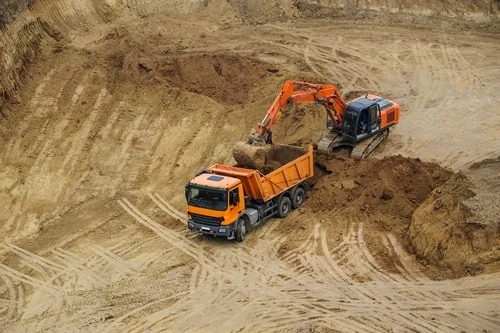Earthworks involve the moving and processing of soil, rock, and other materials to create a desired land surface. This can include tasks like excavation, grading, and trenching. They form the foundation for many construction projects.
Preparation is crucial. Before the work starts, planning and design must take place. This ensures the right amount of material is moved. Calculating the volume of materials, known as earthwork takeoff, is an essential part of this process. Proper planning and execution lead to effective and efficient earthwork operations.
History of Earthwork
Earthwork has been a critical component of human development for thousands of years. Early civilizations used it to build structures, roads, and canals. Techniques have evolved from simple manual labor to sophisticated machinery.
The significance of these practices in history is immense. Without it, many of the ancient wonders and modern infrastructures we see today would not exist. This legacy continues to influence contemporary construction methods and technologies.
Types of Earthwork
There are various categories of earthwork, each serving a distinct purpose in construction and landscaping projects. Excavation involves removing soil or rock from a site to form a cavity or open space. This can be used for foundations, basements, or underground utilities. Grading entails adjusting the slope and elevation of the land to ensure proper drainage and prepare the surface for development.
Another type is trenching, which focuses on creating narrow, deep openings for pipelines or cables. On the other hand, embankment involves adding layers of material to raise the existing ground level for roads, railways, or dams. Each category has its specific techniques and equipment, tailored to achieve the desired land modification efficiently.
Materials Used in Earthwork
Materials used in these projects can vary widely. Common materials include soil, rock, and gravel. Soil is often excavated, moved, and compacted to form a stable base. Rock is used for its durability and strength in construction.
Gravel provides drainage and stability for construction projects. Other materials include sand, clay, and silt. These materials help achieve specific construction goals, such as creating foundations or ensuring proper drainage. Each material has unique properties. The choice depends on the project\'s needs and design specifications.
Equipment and Machinery
Equipment used in earthwork includes heavy machinery like excavators, bulldozers, and loaders. Excavators are versatile; they dig, lift, and move materials. Bulldozers push large quantities of soil and rock. They are essential for grading and leveling land.
Loaders transport materials like soil and debris to various parts of the site. Compactors ensure the ground is compressed and stable. Other specialized equipment, like trenchers and scrapers, is used for specific tasks. All these machines work together to make earthwork efficient and precise. Each piece of equipment is crucial for different stages of the project.
Earthwork Techniques
There are several methods employed to perform various tasks in earthwork. Techniques are chosen based on project requirements and soil conditions. One common method is cut and fill. This involves excavating material from one area and using it to fill another. This balances the site’s elevation and ensures stability.
Another technique is soil stabilization. This improves the strength and durability of the soil, often using additives like lime or cement. Compaction is also crucial. It reduces air gaps in the soil and increases its density. These methods contribute to the overall integrity and success of construction projects.
Environmental Considerations
Environmental considerations are critical in earthwork projects. They involve assessing the impact of construction activities on natural surroundings. This includes evaluating soil erosion, water runoff, and vegetation disruption. Proper planning can minimize adverse effects. Techniques like silt fencing and sediment traps help manage erosion.
Moreover, it is essential to ensure compliance with environmental regulations. This includes obtaining permits and conducting environmental assessments. Projects aim to preserve wildlife habitats and water quality. Using sustainable practices, such as reusing excavated materials, is encouraged. Overall, it’s about balancing development needs with environmental protection.
Safety Measures
Safety is paramount in earthwork. Measures include wearing proper protective gear like helmets and gloves. Workers need to be trained in equipment operation. Regular safety briefings are important. They help reinforce guidelines and address concerns.
Site inspections are crucial. They identify potential hazards and ensure compliance with regulations. Safe practices prevent accidents and injuries. Emergency procedures must be in place. They cover evacuation and first aid. Safety ensures a secure working environment. Supervisors should enforce rules strictly.
Applications of Earthwork
The applications are diverse, spanning multiple industries and uses. In construction, earthwork lays the groundwork for buildings by creating foundations. It also prepares sites for infrastructure such as roads and bridges.
In landscaping, it shapes the terrain and can create features like ponds or terraces. On agricultural lands, earthwork is used for irrigation systems and levee construction. Additionally, it plays a critical role in mining, involving tasks like overburden removal. Each application requires specialized knowledge and skills to ensure effective and efficient results.
Challenges in Earthwork
Earthwork projects often encounter significant obstacles. Weather can pose a challenge; rain can delay progress and cause erosion. Unforeseen soil conditions may require altering plans. For example, finding rock where soft soil is expected can necessitate different equipment or techniques.
Additionally, environmental regulations add complexity. Compliance with laws can involve obtaining permits and conducting environmental assessments. This process can be time-consuming. Proper planning and flexibility are essential to overcoming these challenges. It ensures projects are completed safely, timely, and within budget.
Conclusion
Earthwork is not merely a construction phase; it is the foundation for numerous projects. It ensures the stability, safety, and functionality of structures. By effectively preparing the ground, it sets the stage for successful project completion.
Proper techniques and materials are vital. They guarantee the durability and longevity of the constructed infrastructure. Adhering to environmental and safety standards is crucial. It reduces the risk of accidents and minimizes ecological impact. Overall, earthwork requires meticulous planning and execution. This leads to efficient and sustainable development.



